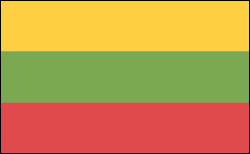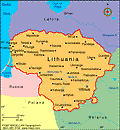Lithuania | Facts & Information

- Lithuania Profile
- History
Facts & Figures
-
President: Dalia Grybauskaite (2009)
Prime Minister: Algirdas Butkevicius (2012)
Total area: 25,174 sq mi (65,200 sq km)
Population (2014 est.): 3,505,738 (growth rate: –0.29%); birth rate: 9.36/1000; infant mortality rate: 6/1000; life expectancy: 75.98
Capital and largest city (2009 est.): Vilnius, 546,000
Monetary unit: Litas
National name: Lietuvos Respublika
Languages: Lithuanian (official) 82%, Russian 8%, Polish 5.6%, other 0.9%, unspecified 3.5% (2011 est.)
Ethnicity/race: Lithuanian 84.1%, Polish 6.6%, Russian 5.8%, Belarusian 1.2%, other 1.1%, unspecified 1.2% (2011 est.)
Religions: Roman Catholic 77.2%, Russian Orthodox 4.1%, Old Believer 0.8%, Evangelical Lutheran 0.6%, Evangelical Reformist 0.2%, other (including Sunni Muslim, Jewish, Greek Catholic, and Karaite) 0.8%, none 6.1%, unspecified 10.1% (2011 est.)
National Holiday: Independence Day, February 16
Literacy: 99.7% (2011 est.)
Economic summary: GDP/PPP (2013 est.): $67.43 billion; per capita $22,600. Real growth rate: 3.4%. Inflation: 1.2%. Unemployment: 12.4%. Arable land: 33.48%. Agriculture: grain, potatoes, sugar beets, flax, vegetables; beef, milk, eggs; fish. Labor force: 1.452 million; industry 19.6%, agriculture 7.9%, services 72.5% (2012 est.). Industries: metal-cutting machine tools, electric motors, television sets, refrigerators and freezers, petroleum refining, shipbuilding (small ships), furniture making, textiles, food processing, fertilizers, agricultural machinery, optical equipment, electronic components, computers, amber jewelry. Natural resources: peat, arable land, amber. Exports: $30.4 billion (2013 est.): mineral products, machinery and equipment, chemicals, textiles, foodstuffs, plastics. Imports: $32.52 billion (2013 est.): mineral products, machinery and equipment, transport equipment, chemicals, textiles and clothing, metals. Major trading partners: Germany, Latvia, Russia, Estonia, Poland, Netherlands, Belarus, UK (2013).
Communications: Telephones: main lines in use: 667,300 (2012); mobile cellular: 5 million (2012). Broadcast media: AM 29, FM 142, shortwave 1 (2001). Radios: 1.9 million (1997). Broadcast media: public broadcaster operates 3 channels with the third channel - a satellite channel - introduced in 2007; various privately owned commercial TV broadcasters operate national and multiple regional channels; many privately owned local TV stations; multi-channel cable and satellite TV services available; publicly owned broadcaster operates 3 radio networks; many privately owned commercial broadcasters, many with repeater stations in various regions throughout the country (2007). Internet Service Providers (ISPs): 1.205 million (2012). Internet users: 1.964 million (2009).
Transportation: Railways: total: 1,767 km (2011). Roadways: total: 84,166 km; paved: 72,048 km; unpaved: 10,083 km (2000). Waterways: 441 km perennially navigable. Ports and terminals: Klaipeda. Airports: 61 (2013).
International disputes: Lithuania and Russia committed to demarcating their boundary in 2006 in accordance with the land and maritime treaty ratified by Russia in May 2003 and by Lithuania in 1999; Lithuania operates a simplified transit regime for Russian nationals traveling from the Kaliningrad coastal exclave into Russia, while still conforming, as a EU member state having an external border with a non-EU member, to strict Schengen border rules; boundary demarcated with Latvia and Lithuania; as of January 2007, ground demarcation of the boundary with Belarus was complete and mapped with final ratification documents in preparation.









